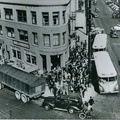Read Part 12 >>
MAINLAND TRADES AND SMALL BUSINESS
By 1910, vigorous Japanese communities were firmly established. The majority of these business establishments was started with a capital investment of less than a thousand dollars and run by the proprietors themselves. Undoubtedly, many of the early business ventures relied on the tanomoshi-ko (a rotating credit association), or other means of mutual support and protection.
In 1909, the Immigration Commission reported between 3,000 to 3,500 Japanese owned business in the Western United States. Most of these establishments were in San Francisco, Los Angeles, Seattle, and Sacramento. Of the 2,277 Japanese surveyed, the Commission found the following breakdown: 381 restaurants; 337 hotels and boarding houses; 187 barbershops; 136 pool-rooms; 136 tailor and dye shops; 124 provision and supply stores; 105 shoe shops, and 97 laundries.1
The family and the network of relatives were the bases of the small business economy found in the Japanese American communities. Families could count on the labor of wives and children. However, if a man could not call upon his family for financial assistance, he would most likely turn to another ken-jin (a person from the same prefectural origin), who was more obligated to give his support.
The ken (prefectures) served as an important basis of group identification since people from the same localized region shared the same customs and dialect. The great significance that the Issei attached to their ancestral home and its locality instantly bonded people from the same prefectures.
The larger prefectural groups formed kenjin-kai (prefectural associations). In Hawaii and on the Mainland the prefectures of Yamaguchi and Hiroshima had the largest representation. Though the kenjin-kai functions were primarily social, relations within the groups sustained the economy and determined patterns of work and association. In Hawaii, for example, people from Wakayama prefecture were mostly engaged in fishery and related industries; Okinawans were prominent in hog-raising and the people from Yamaguchi and Hiroshima were established in business. An old-timer who had settled in Seattle recalled, “There was a tendency toward the concentration of people from the same prefectures in Japan at the same places and in the same lines of work. For example, the barbers in Seattle, from Yamaguchi-ken. . . Homes like those of Mr. I. Were places where young men congregated who were eager to learn things and discuss them, and in the course of their association, they learned such trades as their friends knew.”2
The development of Japanese businesses kept pace with the steady growth of Issei in agriculture as Japanese shopkeepers and produce distributors relied on the fresh fruits and vegetables supplied by Issei farmers. The Japanese farmers assured them better quality produced at cheaper prices and quicker service than their white competitors. The farmers, in turn came to depend upon the urban business for their provisions, capital, and labor supply.
SERVICE WORKERS
In the cities, between 12,000 to 15,000 Japanese found employment in domestic services, working as dishwashers, janitors, waiters, cooks, porters, and butlers. Quite a number of Issei who had come to the United Sates to study worked as “school-boys” in American homes where they did household chores in exchange for room and board and small wages.
Many humorous stories were told of the experiences these young men encountered while learning about American ways. Yone Noguchi, a famous poet who came to America in 1893, recalled how one of his friends terrified the mistress of the house when he proceeded take off his shoes and trousers before scrubbing the floor. “He was afraid he might spoil them,” claimed Noguchi, who, himself, rushed into his “Madam’s toilet room without knocking.”3
Many Issei men found house work quite humiliating. One Issei man wondered, “What would the boys in Japan say if they found me out. . .receiving orders from the maid-servant whom I have once looked down (on) and thought never to be equal while I was dining at my uncle’s house.”4
Though working as a servant was only a means to an end, many never realized their goal of completing school. After they acquired some knowledge of the English language and American ways, quite a few would become labor contractors and leaders in the Japanese community.
Notes:
1. Immigration Commission Reports , Vols. XXIII-XXV, p. 674, in Yamato Ichihashi, Japanese in the United States (Stanford, 1932), pp. 118-119.
2. A.Frank Miyamoto, “An Immigrant Community in America,” in Hilary Conroy and T. Scott Miyakawa (Eds.), East Across the Pacific (Santa Barbara, 1972), pp. 217-243.
3. Noguchi, “Some Stories of My Western Life,” p. 268, in Yuji Ichioka, The Issei , p. 25.
4. Hamilton Holt, (Ed.), Life Stories of Undistinguished Americans (New York, 1906), p. 261.
* Issei Pioneers: Hawai‘i and the Mainland, 1885-1924 is the catalogue accompanying the National Museum’s inaugural exhibition. Using artifacts from the National Museum’s collection to tell the story of the courageous “Issei Pioneers,” the catalogue focuses on the early immigration and settlement years. To order the catalogue >>
© 1992 Japanese American National Museum





